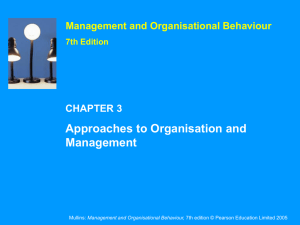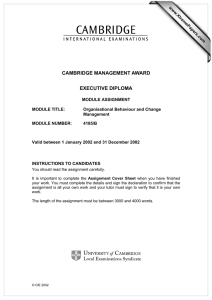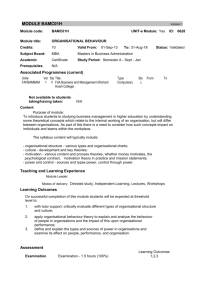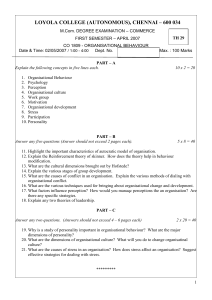Managerial Behaviour and Effectiveness Management and Organisational Behaviour CHAPTER 7
advertisement
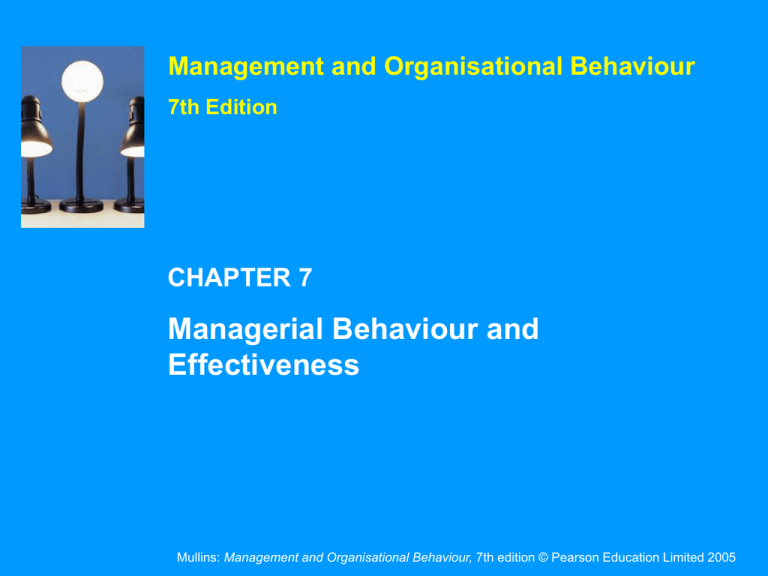
Management and Organisational Behaviour 7th Edition CHAPTER 7 Managerial Behaviour and Effectiveness Mullins: Management and Organisational Behaviour, 7th edition © Pearson Education Limited 2005 OHT 7.2 Managerial style & behaviour • The successful manager has the ability to handle people effectively • People respond according to the manner in which they are treated • The behaviour of managers & their style of management will influence the level of performance achieved by subordinate staff Mullins: Management and Organisational Behaviour, 7th edition © Pearson Education Limited 2005 OHT 7.3 Assumptions about human nature Theory X Theory X assumes that – • The average person is lazy & has an inherent dislike of work • Most people must be coerced, controlled, directed & threatened with punishments if the organisation is to achieve its objectives • The average person avoids responsibility, preferring to be directed • Motivation occurs only at the physiological & security levels Mullins: Management and Organisational Behaviour, 7th edition © Pearson Education Limited 2005 OHT 7.4 Assumptions about human nature Theory Y Theory Y assumes that – • For most people work is as natural as play or rest • People will exercise self-direction & self-control • Commitment to objectives is a function of rewards associated with their achievement • Given the right conditions, the average worker can accept and seek responsibility Mullins: Management and Organisational Behaviour, 7th edition © Pearson Education Limited 2005 OHT 7.5 Assumptions about human nature Theory Y Theory Y assumes that • The capacity for creativity in solving organisational problems is distributed widely • The intellectual potential of the average person is only partially utilised • Motivation occurs at the affiliation, esteem & self-actualisation levels Mullins: Management and Organisational Behaviour, 7th edition © Pearson Education Limited 2005 OHT 7.6 As situations demands • Theory X and Y represent extremes of the natural inclination of managers towards a particular style of behaviour • In practice the actual management style adopted is influenced by the demands of the given situation Mullins: Management and Organisational Behaviour, 7th edition © Pearson Education Limited 2005 OHT 7.7 Japanese Theory Z Characteristics of a Theory Z organisation – • Long-term employment, often for a lifetime • Relatively slow process of evaluation and promotion • Development of company-specific skills & moderately specialised career path Ouchi Mullins: Management and Organisational Behaviour, 7th edition © Pearson Education Limited 2005 OHT 7.8 Japanese Theory Z Characteristics of a Theory Z organisation – • Implicit, informal control mechanisms supported by explicit, formal measures • Participative decision-making but individual ultimate responsibility • Broad concern for the welfare of subordinates & co-workers as a natural part of a working relationship & informal relationships among people Ouchi Mullins: Management and Organisational Behaviour, 7th edition © Pearson Education Limited 2005 OHT 7.9 Blake & Mouton Managerial / leadership grid The grid provides a basis for a comparison of managerial styles in terms of – • A concern for production • A concern for people Mullins: Management and Organisational Behaviour, 7th edition © Pearson Education Limited 2005 OHT 7.10 Figure 7.1 Managerial / leadership grid Source: Blake, R.R. and McCanse, A.A. (1991) Leadership Dilemmas – Grid Solutions, Gulf Publishing Co., Houston (1991), Grid Figure, p.29. Reproduced by permission of Grid International, Inc. Mullins: Management and Organisational Behaviour, 7th edition © Pearson Education Limited 2005 OHT 7.11 Managerial / leadership grid combinations 9,1 – autocratic, relying on centralised systems & authority 1,9 – hold a belief that contented staff will undertake what is required of them & achieve a reasonable level of output 5,5 – middle-of-the-road, live & let live approach with a tendency to avoid the real issues 9,9 – integrate task needs & concern for people Mullins: Management and Organisational Behaviour, 7th edition © Pearson Education Limited 2005 OHT 7.12 Managerial / leadership grid Additional styles • Opportunistic management - organisational performance occurs according to a system of exchanges • Paternalistic /maternalistic management - reward & approval are granted to people in return for loyalty & obedience; punishment is threatened for failure to comply Mullins: Management and Organisational Behaviour, 7th edition © Pearson Education Limited 2005 OHT 7.13 Dominant style of management The dominant style of management is influenced in any particular situation by: • Organisation - the nature of the organisation in which a manager is employed • Values - the personal values, beliefs or ideals of the manager • Personal history - the deep rooted personal history of the manager • Chance - chance has not provided the manager with an opportunity to learn Mullins: Management and Organisational Behaviour, 7th edition © Pearson Education Limited 2005 OHT 7.14 Likert’s management system 1. Exploitive authoritative – decisions imposed on staff & motivation is based on threats 2. Benevolent authoritative – condescending form of leadership with motivation based on system of rewards 3. Consultative – some trust in staff, motivation based on rewards & also some involvement 4. Participative – involves trust & confidence in staff with motivation based on rewards for achievement of agreed goals Mullins: Management and Organisational Behaviour, 7th edition © Pearson Education Limited 2005 OHT 7.15 Supportive relationships These relationships are intended to enhance selfesteem and ego building. They contribute to subordinates’ sense of personal worth, significance and dignity. Mullins: Management and Organisational Behaviour, 7th edition © Pearson Education Limited 2005 OHT 7.16 Supportive relationships A superior’s behaviour is supportive when there is: • • • • • • Mutual confidence & trust Opportunity to maintain a good income An understanding of work problems & help in doing the job Genuine interest in personal problems Help with training to assist promotion A sharing of information Mullins: Management and Organisational Behaviour, 7th edition © Pearson Education Limited 2005 OHT 7.17 Management by objectives (MBO) A management style or system that relates organisational goals to individual performance & development through involvement of all levels of management The basis for MBO is – • The setting of objectives & targets • Participation by individual managers in agreeing unit objectives & criteria of performance • The continual review & appraisal of results Mullins: Management and Organisational Behaviour, 7th edition © Pearson Education Limited 2005 OHT 7.18 Figure 7.4 The cycle of MBO activities Mullins: Management and Organisational Behaviour, 7th edition © Pearson Education Limited 2005 OHT 7.19 MBO advantages & constraints • Provides the opportunity for staff to accept greater responsibility & make higher level of personal contribution • Modern form of scientific management • Places too much emphasis on individual job definition & management authority structure • Assumes no conflict between individual & organisational goals • Not always easy to set specific targets or figures for senior jobs Mullins: Management and Organisational Behaviour, 7th edition © Pearson Education Limited 2005 OHT 7.20 Five essential principles Successful management of people is based on: • honesty, trust, openness, mutual respect, co-operation & support • a perception of employees as an essential asset to be invested in • a clearly established set of principles applied in daily tasks • fundamental leadership relating to vision, charisma & ability to gain team commitment & co-operation • the establishment of essential practices such as setting high standards & achieving them Mullins: Management and Organisational Behaviour, 7th edition © Pearson Education Limited 2005 OHT 7.21 Figure 7.5 The effective management of people Mullins: Management and Organisational Behaviour, 7th edition © Pearson Education Limited 2005 OHT 7.22 The golden rule management philosophy • • • • • Trust people fairly but according to merit Make others feel important Motivate people by praise Encourage feedback Sandwich every bit of criticism between two layers of heavy praise • Have an open-door philosophy • Help other people get what they want • Never hide behind policy or pomposity Mullins: Management and Organisational Behaviour, 7th edition © Pearson Education Limited 2005 OHT 7.23 Managerial effectiveness A study by Proudfoot Consulting reported that – Poor planning & inadequate management are still the key reasons for the majority of time wasted globally in the workplace Mullins: Management and Organisational Behaviour, 7th edition © Pearson Education Limited 2005 OHT 7.24 Effective & successful managers Luthans makes the following distinction: • Effective managers – defined in terms of the quantity & quality of standards of performance & the satisfaction & commitment of subordinates • Successful managers – defined operationally in terms of the speed of their performance within the organisation Mullins: Management and Organisational Behaviour, 7th edition © Pearson Education Limited 2005 OHT 7.25 Assessing a manager’s effectiveness A manager’s effectiveness can be assessed using the following: • The strength of motivation & the morale of staff • The success of their training & development • The creation of an organisational environment in which staff work willingly & effectively • Meeting important deadlines • Accuracy of work • Level of complaints • Adherence to quality standards • Productivity • Adhering to budgets set Mullins: Management and Organisational Behaviour, 7th edition © Pearson Education Limited 2005 OHT 7.26 Figure 7.9 The 3-D model of managerial effectiveness Source: Reddin, W.J. Managerial Effectiveness, McGraw-Hill (1970) p.206 Mullins: Management and Organisational Behaviour, 7th edition © Pearson Education Limited 2005 OHT 7.27 The 3-D model of managerial effectiveness Less effective are the – Missionary Compromiser Deserter Autocrat Mullins: Management and Organisational Behaviour, 7th edition © Pearson Education Limited 2005 OHT 7.28 The 3-D model of managerial effectiveness More effective are the – Developer Executive Bureaucrat Benevolent autocrat Mullins: Management and Organisational Behaviour, 7th edition © Pearson Education Limited 2005 OHT 7.29 General criteria of managerial effectiveness • • • • • The manager’s work The manager him/herself The manager’s relationship with other people The manager as part of the organisation Criterion of general effectiveness Mullins: Management and Organisational Behaviour, 7th edition © Pearson Education Limited 2005
